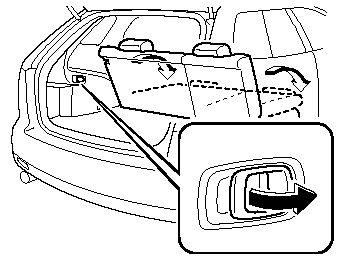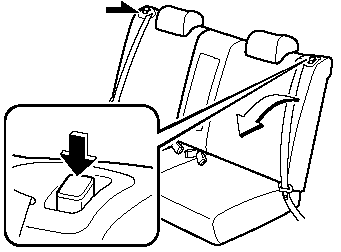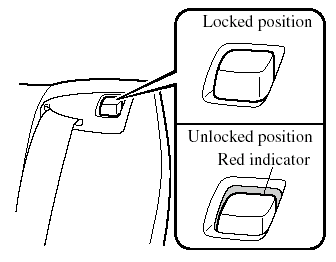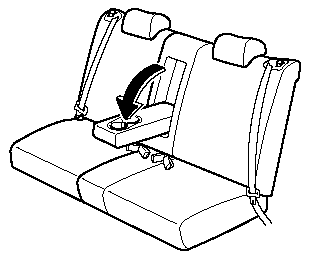Rear Seat
WARNING:
Do not stack cargo higher than the
seatbacks:
Stacking luggage or other cargo
higher than the seatbacks, and
placing articles on the rear seat is
dangerous. During sudden braking
or a collision, objects can fly around
and become projectiles that may hit
and injure passengers.
Make sure luggage and cargo is
secured before driving:
Not securing cargo while driving is
dangerous as it could move or be
crushed during sudden braking or a
collision and cause injury.
Make sure the adjustable components of a seat are locked in place: Adjustable seats that are not securely locked are dangerous. In a sudden stop or collision, the seat or seatback could move, causing injury.
Do not drive with the seatback
unlocked:
The seatback plays an important role
in your protection in a vehicle.
Leaving the seatback unlocked is dangerous as it can allow passengers to be ejected or thrown around and baggage to strike occupants in a sudden stop or collision, resulting in severe injury. After returning the seatback at any time, even when there are no other passengers, rock the seatback to make sure it is locked in place.
Never allow a passenger to sit or stand
on the folded seatback while the
vehicle is moving:
Driving with a passenger on the
folded seatback is dangerous.
Allowing a child to sit up on the folded seatback while the vehicle is moving is particularly dangerous. In a sudden stop or even a minor collision, a child not in a proper seat or child-restraint system and seat belt could be thrown forward, back or even out of the vehicle resulting in serious injuries or death. The child in the baggage area could be thrown into other occupants and cause serious injury.
NOTE:
When returning a rear seat to its original
position, also replace the seat belt to its
normal position. Verify that the seat belt pulls
out and retracts.
Split-Folding Rear Seatback
The seatbacks can be folded down to provide more space in the luggage compartment.
To fold the seatbacks
WARNING:
Always remove the child-restraint
system from the rear seat before
operating the remote handle levers for
the rear seat:
Operating the remote handle levers
while a rear-facing child-restraint
system is in the rear seat is
dangerous. It could cause injury to a
child seated in the child-restraint
system when the seatback suddenly
flips forward.
Make sure there is nobody in the rear
seat area before operating the remote
handle levers:
Not checking the rear seat area for
persons before folding the seatbacks
with the remote handle levers is
dangerous. The rear seat area is
difficult to see from the rear of the
vehicle. Operating the remote handle
levers without checking could cause
injury to a person when a seatback
suddenly flips forward.
CAUTION:
Before folding the seatbacks with the
remote handle levers, make sure
there is no cup in a rear cup holder.
Folding the seatbacks with the remote handle levers while a cup is in the cup holder could soil or damage the seat bottom and seatback.
When using the remote handle levers:
CAUTION:
Be careful of the following when
using the remote handle levers:
 On a downward slope, the
On a downward slope, the
seatback could flip forward faster
than on a flat area.
 On an upward slope, the seatback
On an upward slope, the seatback
may not fold down. When the
seatbacks cannot be folded down
with levers, pull the rear seatback
forward from inside the vehicle.
1. Unfasten the lap portion of the centerrear seat belt.
CAUTION:
Always unfasten the lap portion of
the belt before folding left-rear
seatback. Leaving the lap portion of
the belt fastened could cause
damage to the seat belt, buckle and
seatback.

2. After checking that the rear seats are clear, open the liftgate compartment and pull the remote handle levers on the left and right side of the liftgate compartment.
When using the rear seatback knobs:
CAUTION:
When operating the rear seatback
knob, make sure you support the
seatback with your hand. If the
seatback is not supported with your
hand, it will flip forward suddenly
and could cause injury to the finger
that pushes the rear seatback knob
down.
1. Unfasten the lap portion of the centerrear seat belt.
CAUTION:
Always unfasten the lap portion of
the belt before folding the rear-left
seatback. Leaving the lap portion of
the belt fastened could cause
damage to the seat belt, buckle and
seatback.
2. Support the seatback with your hand.

3. Push the rear seatback knob down.
To return the seatbacks to the upright position
1. Lift the seatbacks upright.
2. Pull on the top of the seatbacks from inside the vehicle to make sure they are locked.
3. Fasten the center-rear lap/shoulder belt and check that all seat belts are routed properly for passenger use.
WARNING:
Always make sure the seat belts are
fully pulled out from under the
seatbacks:
A seat belt caught under a seatback
after the seatback is returned to its
upright position is dangerous. In a
collision or sudden stop, the seat belt
cannot provide adequate protection.
When returning the seatback to the
upright position, make sure there is no
red indication:
A rear seatback not fully returned
and locked in the upright position is
dangerous. Sudden stops or
maneuvering could cause a seatback
to flip forward suddenly resulting in
injury. If the red indicator is visible on
the back of the rear seatback knob,
the seatback is not locked in the
upright position.

Armrest

The rear armrest in the center of the rear seatback can be used (no occupant in the center seat) or placed upright.
See also:
Trailer Towing
The Mazda5 is not designed for towing.
Never tow a trailer with your Mazda5. ...
Driving Impressions
The Mazda6 is pleasant to drive and sportier than some of its rivals. This
sedan takes curves confidently with modest body lean and satisfying grip.
Moderate steering effort is accompanied by good ...
Tire Pressure Monitoring System
The tire pressure monitoring system (TPMS) monitors the pressure for each
tire.
If tire pressure is too low in one or more tires, the system will inform the
driver via the
warning light in the i ...


